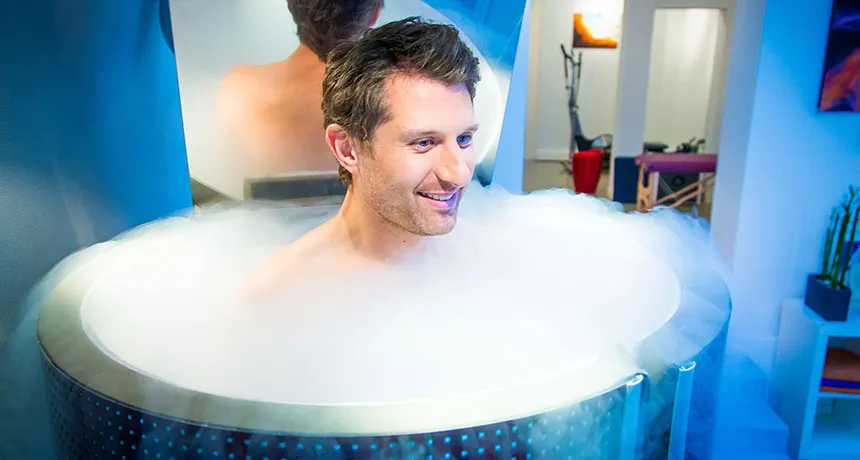Putting the big chill on cryotherapy
There’s no evidence yet showing that exposure to extreme cold eases muscle soreness after exercise

COOLING OFF A few minutes in a cryotherapy cabin can chill the muscles and skin, but whether the treatment is effective for easing muscle soreness remains unclear.
Philippe Garo/Science Source
For about $40 and a few minutes, a person can get a dose of icy air in a chamber colder than Antarctica.
It’s called whole-body cryotherapy, and proponents say the treatment can ease muscle soreness and help athletes recover from exercise and injury. “A lot of athletes are using it as an alternative to ice baths,” says Joe Costello, an exercise physiologist at the University of Portsmouth in England.
In recent years, cryotherapy has moved out of the elite athlete arena and into mainstream use. Now, health spas across the United States offer the treatment, which recently drew national attention when a Nevada spa worker was found dead after hours inside a chill chamber. Some centers claim that cryotherapy dulls pain and reduces inflammation by releasing endorphins and boosting blood circulation.
But for treating or preventing sore muscle at least, the science to support whole-body cryotherapy just isn’t there, Costello and colleagues report online September 18 in The Cochrane Library. “There’s simply insufficient evidence for us to say the treatment is or isn’t effective,” Costello says.
In a typical cryotherapy session, customers strip down and step into a chamber that’s like a sauna, but chilled with refrigerated air to below ‒100° Celsius. Some spas use smaller liquid nitrogen‒cooled chambers that let customers keep their heads out of the frigid air. In both versions, people are exposed to the cold for about two to four minutes. The treatment chills the skin and muscle — though people don’t get nearly as cold as the chamber’s air. In a 2012 study in PLOS ONE, Costello and colleagues reported skin temperatures were about 19°C after four minutes in a cryochamber — about 10 degrees colder than normal. (During treatment, though, skin temperatures can reach as low as ‒35°C, a 2013 study found.)
Cooling the body’s tissues triggers all sorts of effects, Costello says, such as reducing blood flow, slowing metabolism and slowing down nerve signals that typically race to the brain. But exactly how (and if) cooling works to treat injuries remains murky.
The first whole-body cryotherapy chamber was developed in Japan in the 1970s for inflammatory diseases like rheumatoid arthritis, though physicians have used other, less-extreme forms of body chilling to treat various medical conditions for years. Chilling seems to help newborn babies who have been deprived of oxygen, says pediatric neurologist John Kerrigan of Phoenix Children’s Hospital. Some studies suggest that mild hypothermia keeps cells from self-destructing and switches on neural-protective genes.
But those newborns represent a very specific scenario — so people can’t assume cooling helps patients with other problems, Kerrigan says. Chillingheart attack victims, for example, doesn’t actually do much to protect tissues, recent studies suggest. The practice may even make patients more vulnerable to pneumonia (SN Online: 11/18/13). Kerrigan’s not convinced about the benefits of whole-body cryotherapy for sore muscles, either. “I’m not going to say it doesn’t work,” he says, “But we certainly don’t have evidence that it does.”
Costello and colleagues searched for such evidence by scanning thousands of studies. The team found four small studies, with a total of 64 participants,that looked at the effects of whole-body cryotherapy versus another type of treatment or no treatment for muscle soreness and recovery.
Some of the studies reported slight benefits, “but when you pool all the data together, the results aren’t as clear,” Costello says. More definitive results would require “more studies, more data, and more than 64 people,” he says.
And none of the studies Costello and colleagues examined actually reported whether the treatment had any negative side effects.
The field definitely needs more work, agrees Borut Fonda, a sports scientist Sports Cycling, Ltd. inLjubljana, Slovenia, whose work was included in Costello’s analysis. But he still thinks some athletes could find whole-body cryotherapy helpful. “I think there’s a chance it will be shown as very useful.”
In the meantime, soaking in an ice bath may be an easier way to cool off.
Despite the 100 or so degree difference between the cold air of whole-body cryotherapy and the cold water of an ice bath, a few minutes of either treatment cools the body a similar amount, Costello and colleagues found. Still, there’s not much evidence that ice baths improve athletes’ recovery or performance either — though a cold soak does seem to ease muscle pain after exercise.







